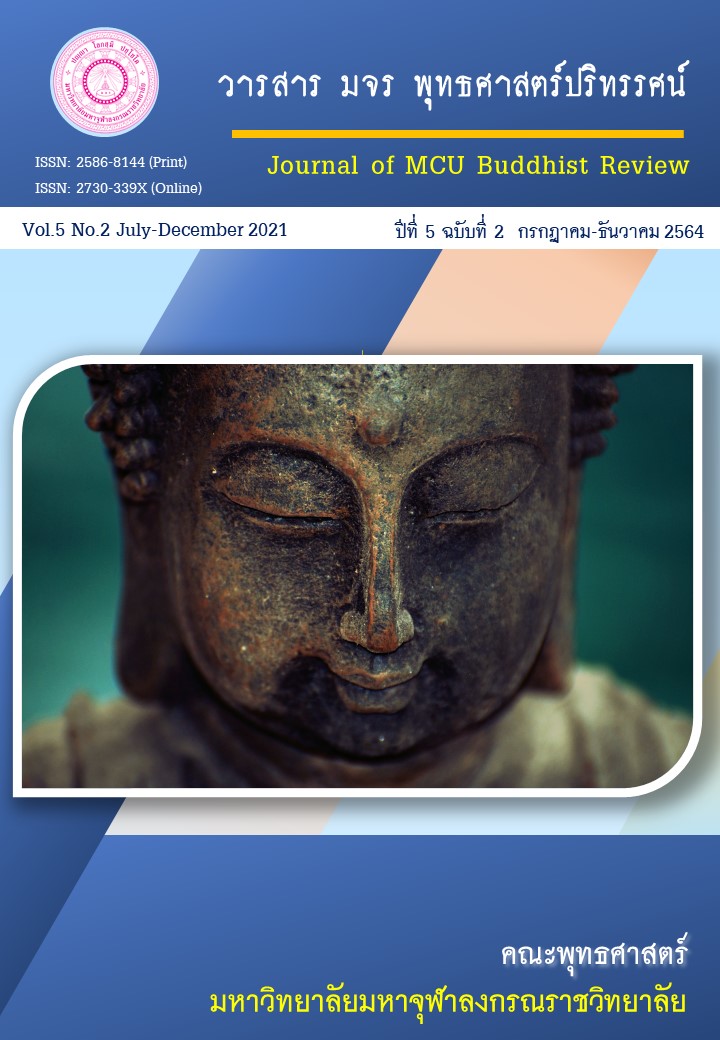การศึกษารหัสพุทธธรรมจากอักษรย่อแบบไม่ระบุชื่อหัวใจในคัมภีร์หัวใจ 108
Main Article Content
บทคัดย่อ
การวิจัยนี้มีวัตถุประสงค์เพื่อศึกษาแหล่งที่มาและวิธีการย่ออักษรแบบไม่ระบุชื่อหัวใจในคัมภีร์หัวใจ 108 และศึกษารหัสพุทธธรรมและการนำอักษรย่อแบบไม่ระบุชื่อหัวใจในคัมภีร์หัวใจ 108 ไปใช้ โดยใช้ระเบียบวิธีวิจัยเชิงคุณภาพโดยการวิเคราะห์ข้อมูลจากเอกสาร และนำเสนอเป็นรายงานการวิจัยแบบพรรณนาวิเคราะห์
ผลการวิจัยพบว่า อักษรย่อแบบไม่ระบุชื่อหัวใจในคัมภีร์หัวใจ 108 ส่วนใหญ่มาจากคัมภีร์ทางพระพุทธศาสนา เช่น พระไตรปิฎก รวมถึงบทสวดมนต์ต่าง ๆ แต่มีอักษรย่อบางส่วนที่มาจากความเชื่อในศาสนาพราหมณ์-ฮินดู และเวทมนตร์คาถาทางไสยศาสตร์ วิธีการย่ออักษรตามคัมภีร์วชิรสารัตถสังคหะพบ 3 รูปแบบ คือ การย่ออักษรตัวแรกของศัพท์ การย่ออักษรตัวสุดท้ายของศัพท์ การย่ออักษรที่ใช้วิธีทั้งสองข้อข้างต้นร่วมกัน รหัสพุทธธรรมที่พบ ได้แก่ พระพุทธเจ้า พระรัตนตรัย พระธรรม พุทธสาวกบางรูป พระเถระหลังพุทธกาล ชื่อคัมภีร์ พิธีกรรม ศาสนวัตถุ เหตุการณ์สำคัญในพระพุทธศาสนา นิทานธรรม ส่วนวิธีการนำอักษรไปใช้พบ 2 ลักษณะ คือ การไปใช้ตามคติทางพระพุทธศาสนา ได้แก่ การนำมาใช้สื่อแหล่งที่มา ชื่อและความหมายของหัวใจ เรื่องที่เกี่ยวกับพระพระพุทธศาสนาที่กล่าวข้างต้น ใช้เป็นคำภาวนาฝึกจิตให้เป็นสมาธิ และอุบายเตือนสติให้ตั้งมั่นอยู่ในความดี และการนำไปใช้ตามคติความเชื่อทางไสยศาสตร์ทั้งทางที่ดี เช่น ป้องกันภัย และทางที่ไม่ดี เช่น นำไปใช้ทำร้ายคนอื่นให้วิบัติ เป็นต้น
Article Details

อนุญาตภายใต้เงื่อนไข Creative Commons Attribution-NonCommercial-NoDerivatives 4.0 International License.
- บทความที่ได้รับการตีพิมพ์เป็นลิขสิทธิ์ของวารสาร มจร พุทธศาสตร์ปริทรรศน์
- ข้อความใดๆ ที่ปรากฎในบทความที่ได้รับการตีพิมพ์ในวารสาร ถือเป็นความรับผิดชอบของผู้เขียนบทความ และข้อคิดเห็นนั้นไม่ถือว่าเป็นทัศนะและความรับผิดชอบของกองบรรณาธิการวารสาร มจร พุทธศาสตร์ปริทรรศน์
เอกสารอ้างอิง
กรมศิลปากร. (2529). จารึกในประเทศไทย เล่ม 5. กรุงเทพมหานคร: หอสมุดแห่งชาติ.
ธีรโชติ เกิดแก้ว. (2552). ศึกษาวิเคราะห์สัญลักษณ์ทางพระพุทธศาสนาที่ปรากฏในยันต์ไทย. สมุทรปราการ: มหาวิทยาลัยหัวเฉียวเฉลิมพระเกียรติ.
ธีรโชติ เกิดแก้ว. (2560). การศึกษาวิเคราะห์อักษรย่อในคัมภีร์หัวใจ 108 ในฐานะสื่อการสอนพระพุทธศาสนา. สมุทรปราการ: มหาวิทยาลัยหัวเฉียวเฉลิมพระเกียรติ.
พระพิษณุพล สุวณฺณรูโป (รูปทอง). (2555). ศึกษาหลักพุทธธรรมและคุณค่าที่ปรากฏในยันต์เทียนล้านนา: กรณีศึกษาเฉพาะในเขตอำเภอเมือง จังหวัดลำปาง. วิทยานิพนธ์พุทธศาสตรมหาบัณฑิต มหาวิทยาลัยมหาจุฬาลงกรณราชวิทยาลัย.
พระสิริรัตนปัญญา มหาเถระ. (ม.ป.ป.). วชิรสารตฺถสงฺคหํ ปกรณํ. แย้ม ประพัฒน์ทอง ผู้แปล. ม.ป.ท.
พระพุทธโฆสาจารย์. (2523). ธมฺมปทฏฺฐกถาย ทุติโย ภาโค (พิมพ์ครั้งที่ 21). กรุงเทพมหานคร: โรงพิมพ์มหามกุฎราชวิทยาลัย.
พระมหาประเสริฐ ชุตินฺธโร (สุนทรวัฒน์). (2542). การศึกษาเชิงวิเคราะห์เรื่องไสยศาสตร์กับพุทธศาสตร์ตามทรรศนะของพระธรรมปิฎก (ป.อ.ปยุตฺโต). วิทยานิพนธ์พุทธศาสมหาบัณฑิต มหาวิทยาลัยมหาจุฬาลงกรณราชวิทยาลัย.
มหาจุฬาลงกรณราชวิทยาลัย. (2514-2515). พระไตรปิฎกภาษาบาลี ฉบับมหาจุฬาเตปิฏกํ 2500. กรุงเทพมหานคร: โรงพิมพ์การศาสนา.
มหาจุฬาลงกรณราชวิทยาลัย. (2539). พระไตรปิฎกภาษาไทย ฉบับมหาจุฬาลงกรณราชวิทยาลัย. กรุงเทพมหานคร: โรงพิมพ์มหาจุฬาลงกรณราชวิทยาลัย.
อุระคินทร์ วิริยะบูรณะ. (ม.ป.ป., ง). คัมภีร์หัวใจ 108 ฉบับพิสดาร. กรุงเทพมหานคร: สำนักงานลูกส. ธรรมภักดี.


